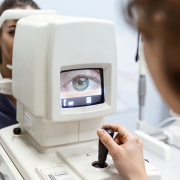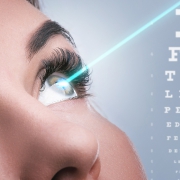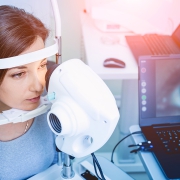LASIK and Dry Eyes: How to Manage the Discomfort
If you’re considering LASIK, you might be wondering about the potential complications. In this article, we’ll explore dry eye syndrome and how it’s related to LASIK. We’ll also look at some ways to manage your symptoms after surgery so that you can have a happy and healthy post-LASIK life.
Dry eye syndrome (DES)
Dry eye syndrome (DES) is a common condition that can be caused by a number of factors. The most common cause of DES is aging, but it can also be caused by environmental factors such as wind and low humidity, or lifestyle choices like smoking or using computers for long periods of time without taking breaks. Symptoms include dryness, irritation, burning and itching in the eyes as well as blurred vision.
For those who suffer from this condition there are several options available for treatment including artificial tears which help to lubricate the surface of your eyes so they don’t feel so dry all the time; punctal plugs which stop any drainage from happening through your tear ducts; punctal cautery which seals off one or both of these openings permanently so no fluid escapes at all; taping lower eyelids closed at night while sleeping to prevent them from drooping over onto eyelashes during sleep (which causes irritation); wearing goggles while swimming outdoors where chlorinated water may irritate sensitive corneas further still
What is LASIK?
LASIK is a type of laser eye surgery used to improve vision. It’s also known as laser-assisted in situ keratomileusis (LASIK). The procedure involves reshaping the cornea, which is your clear outer layer that covers your iris and pupil. The excimer laser makes thousands of precise cuts in this layer so it can be folded back into place, giving you better vision than before.
Risk of Dry Eyes Following LASIK
If you have dry eyes, you are not alone. Approximately 15% of people who undergo laser eye surgery (LASIK) develop dry eyes as a side effect. Dryness can be a long-term problem that may require treatment and daily lubrication.
Dry eyes are common after LASIK because the cornea is weakened by the surgery. The cornea is the clear outer layer of your eye, which helps focus light onto retinal cells in an area called fovea centralis that allows us to see clearly at all distances and under all conditions–from bright sunlight to dim lighting conditions like candlelight or moonlight! Without enough moisture on its surface, this sensitive tissue can become inflamed or injured easily over time leading up to discomforting symptoms such as burning pain when exposed directly into sunlight (photo sensitivity), blurred vision from excess tears pooling below eyelids instead of being released naturally through tear glands located underneath each eye lid (epiphora), excessive blinking due to irritation caused by foreign particles such as dust particles entering into open wounds created during healing process after surgery takes place
How long does it take to recover from dry eyes after LASIK surgery?
It takes about a week for your eyes to recover from the dryness that can result from LASIK surgery. Dry eyes are not a permanent condition, however, and they will subside with time.
While it’s true that some patients experience dry eye after their procedure, it’s important to know that this is not the only cause of uncomfortable symptoms such as burning, stinging or itching in the eyes. Other factors include:
- Age (older people tend to have more problems)
- Gender (men are more likely than women)
What can be done to prevent or manage dry eyes after LASIK?
You can manage the discomfort of dry eyes by using preservative-free artificial tears. These medications have been shown to be effective in treating mild cases of dry eye syndrome, and they can also help reduce the risk of developing severe symptoms.
As an alternative to artificial tears, consider applying warm compresses directly over your closed eyelids for five minutes three times per day. This will help increase blood flow and lubrication to your corneas, reducing pain and irritation.
In addition to these measures, try not rubbing your eyes as much as possible when they’re feeling dry or irritated; this will prevent further damage from occurring underneath the surface layers of skin on your face (which can cause inflammation). You should also use humidifiers throughout the winter months because cold air dries out mucus membranes such as those located inside our noses–and therefore also those within our eyes!
Finally: if all else fails…wear sunglasses! Glasses with polarized lenses protect against UV rays while helping block out harmful rays coming from computer monitors/smartphones/etcetera–and thus reduce stress placed upon these tissues while providing additional warmth throughout winter weather conditions (especially during long commutes).
Why is preservative-free artificial tears a must for people with dry eyes?
Preservative-free artificial tears are a must for people with dry eyes. The preservatives found in many eye drops can cause dryness, irritation and even allergic reactions. These ingredients include benzalkonium chloride, edetate disodium and polyvidone. Some artificial tears also contain preservatives such as propylene glycol or parabens that can be toxic to the eye if they get into it accidentally during application or wear time.
These chemicals may cause an increase in ocular surface inflammation which makes your eyes more prone to developing infections like conjunctivitis (pink eye). They also increase the risk of contact lens complications like scratches on your lenses or corneal ulcers from prolonged use without cleaning them properly between uses.
If you’re going to have LASIK, get the right eye drops
If you’re going to have LASIK, get the right eye drops. Preservative-free eye drops are recommended for contact lens wearers and people with dry eyes. They may be more expensive than other types of eye drops, but they’re worth it because they won’t cause further irritation to your eyes.
If you’ve been prescribed preservative-free or “saline” eyedrops by an ophthalmologist or optometrist, use them as directed (typically four times per day). If you don’t want to invest in a special prescription bottle of saline solution from your doctor’s office, try purchasing it online instead–you’ll save money and still get reliable results from your purchase! Remember: Never use nonprescription products such as Visine or artificial tears; these contain preservatives that can irritate the surface of your cornea even more after LASIK surgery has already caused some damage there anyway!
Conclusion
Dry eyes are a common side effect of LASIK surgery, but they can be managed with the right treatment. We recommend preservative-free artificial tears for people with dry eyes. If you’re going to have LASIK, make sure you get the right eye drops before and after surgery so that your eyes stay healthy and comfortable throughout the recovery process!









